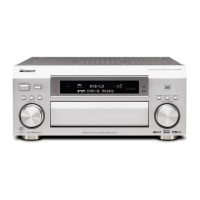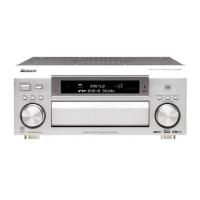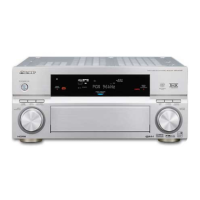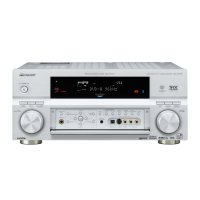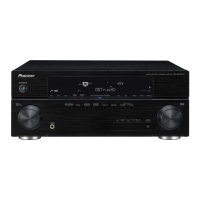Why is the display dark on my Pioneer VSX-AX3-K Receiver?
- AAllen ProctorSep 12, 2025
The display DIMMER button may be pushed. Press DIMMER on the remote control repeatedly to return to the default setting.
Why is the display dark on my Pioneer VSX-AX3-K Receiver?
The display DIMMER button may be pushed. Press DIMMER on the remote control repeatedly to return to the default setting.
What to do if there is no sound output when a function is selected on my Pioneer Receiver?
Check the following: * Ensure all components/speakers are connected correctly. * Press MUTING on the remote control to unmute. * Adjust MASTER VOLUME to increase the volume. * Press SPEAKERS (A/B) to select the connected speakers. * Select the proper signal with the SIGNAL SELECT button. * Turn MULTI CH IN mode off.
How to fix considerable noise in radio broadcasts on Pioneer Receiver?
First, tune in the correct frequency. Then, ensure the antenna is properly connected. Also, route digital cables away from the antenna terminals and wires, as they may cause interference.
What to do if my Pioneer VSX-AX3-K power does not turn on?
First, ensure the power plug is securely connected to the wall outlet. If it still doesn't turn on, the protection circuit may have been activated. Disconnect the power plug from the outlet, wait a few seconds, and then plug it back in.
Why can’t I get DIGITAL to come up when using the SIGNAL SELECT button on my Pioneer Receiver?
Either the digital connections or the DIGITAL IN SELECT is incorrect. Make sure the digital connections and the DIGITAL IN SELECT are done correctly. MULTI CH IN mode may be on, so turn MULTI CH IN mode off.
Why can’t other components be operated with the system remote of my Pioneer VSX-AX3-K Receiver?
The preset code settings may be wrong, so input the correct preset code. The batteries may have worn out and the system settings were cleared, so reset the proper system settings.
Why does a multi channel DVD source appear to be downmixed from 2 channels during playback on my Pioneer VSX-AX3-K?
The source may be coming from something other than the MULTI CH IN jacks. Check the MULTI CH IN connection and select the type of playback with the MULTI CH IN button.
Why can't broadcast stations be selected automatically on my Pioneer VSX-AX3-K Receiver?
The antenna may be poorly positioned, so adjust the direction and position for best reception. There may be interference caused by other equipment (fluorescent lamp, motor, etc.), so turn off the equipment causing the noise or move it away from the receiver. The radio signals may be weak, so connect an outdoor AM or FM antenna.
Why the SR cable is connected, but the connected components can’t be operated with the remote of my Pioneer VSX-AX3-K Receiver?
The SR cable may not have been connected properly, so reinsert the SR cable, making sure it is the right jack. The rest of the component connection may not have been made, so make sure an analog connection has been made between the units. The component you have hooked up may not be SR compatible. This is not a malfunction.
What does FAN STOP blinking in the display of my Pioneer VSX-AX3-K mean?
Something may be stuck in the fan, or the fan is broken. Remove any foreign object from the fan. If you can’t do this, or the fan is broken, call a Pioneer-accredited repair center to look at the problem.
Details the Multichannel Acoustic Calibration EQ System for easy setup.
Highlights support for Dolby Digital EX, DTS-ES, DTS 96/24, and HD video.
Explains the fundamentals of home theater setup: system, source, and listening modes.
Guide for connecting DVD player and TV, including digital and analog audio.
Instructions for connecting front, center, surround, and surround back speakers.
Step-by-step guide for automatic surround sound configuration using MCACC.
Instructions for connecting various video devices like DVD players and VCRs.
Instructions for connecting digital audio sources via coaxial or optical cables.
Detailed instructions for connecting speaker systems, including surround back.
Overview and explanation of all buttons and indicators on the front panel.
Detailed description of buttons on the remote control and their functions.
Overview of options: SURRBACK SYSTEM, AUTO SETTING, NORMAL, and EXPERT.
Manual adjustment of sound parameters for surround sound.
Guides on selecting speaker sizes and routing bass frequencies.
Balancing sound output levels for individual speakers using test tones.
Adjusting delay levels based on speaker distance for sound depth.
How to play sound sources and adjust volume.
Overview of STEREO, DIRECT, MOVIE, and MUSIC listening modes.
Programming the remote to control other audio/video components.
Mapping digital input terminals to specific components.
Introduction to advanced settings for fine-tuning surround sound.
Precise balancing of sound output levels for each speaker.
Adjusting speaker delay for better sound depth and separation.
Using EQ AUTO SETTING and custom EQ preferences (CUSTOM 1/2).
Details on Dolby Digital, Dialog Normalization, Pro Logic II, and Surround EX.
Information on DTS, DTS-ES, DTS Neo:6, and DTS 96/24 formats.
Guide to diagnosing and resolving problems with power, sound, and unit operation.

